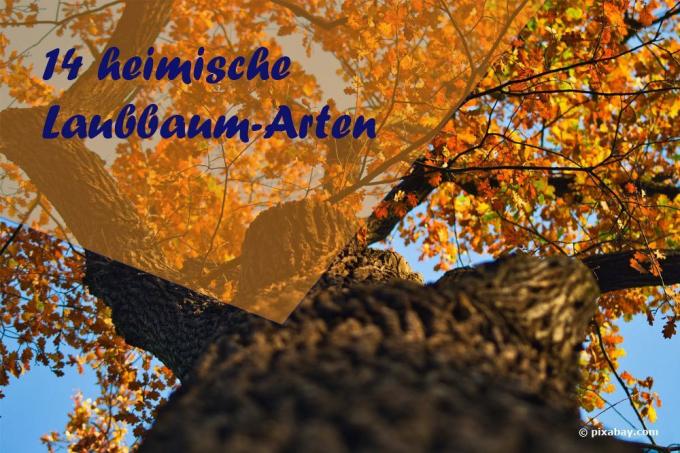
table of contents
- Apple tree (Malus domestica)
- Beech (Fagus sylvatica)
- Tree magnolia (Magnolia kobus)
- German oak (Quercus robur)
- Sweet chestnut (Castanea sativa)
- Silver birch (Betula pendula)
- Cherry (Prunus avium)
- Mirabelle plum (Prunus domestica subsp. Syriaca)
- Horse chestnut (Aesculus hippccastanum)
- Sal willow (Salix caprea)
- Norway maple (Acer plantanoides)
- Rowanberry (Sorbus aucuparia)
- Wild apple (Malus sylvestris)
- Quaking aspen (Populus tremula)
Deciduous trees are not only known from the forest, they also adorn parks and magnificent avenues. Of course, fruit trees are also welcome guests in the garden. There are innumerable indigenous deciduous tree species in Germany. They are important suppliers of wood, a source of food for humans and animals, not to forget valuable oxygen suppliers. In autumn they enchant you with a splendid foliage color. Below is a small overview of different types of deciduous trees.
Apple tree (Malus domestica)
The apple tree originally comes from Asia. It has been cultivated there for many thousands of years. Due to the breeding there are innumerable varieties and new ones are added every year.
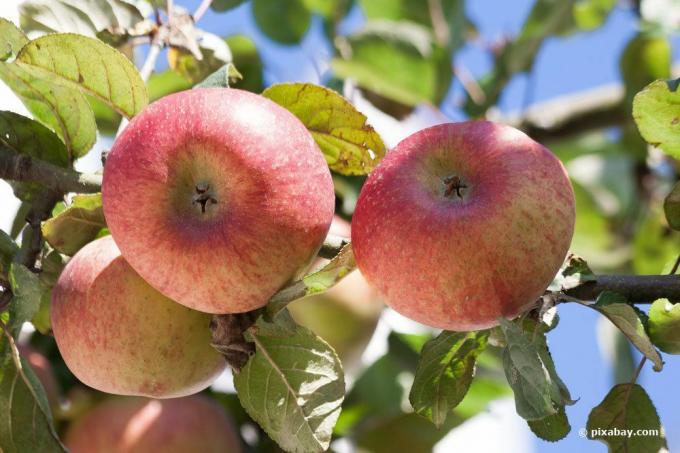
Appearance:
- Height 10 m
- dark green ovate leaves
- sawn, upwardly curved leaf margins
- white-red flowers in April / May
- red-brown branches
- yellow autumn colors
- Drupe different in color and size
- depending on the variety
- Shallow root
- sunny to partially shaded location
- nutrient-rich, loose soil
Beech (Fagus sylvatica)
It is also known as the common beech and is one of the most important native deciduous tree species. The reddish wood is used in the furniture industry and also as firewood. The color of the wood also gave the deciduous tree its name.
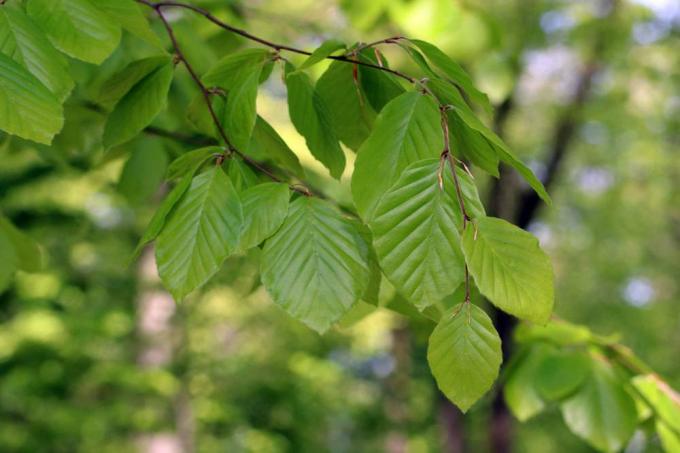
Appearance:
- Height 30 m
- slender, straight trunk
- domed dense crown
- smooth, gray bark
- Brown-gray branches with ovate leaves that are pointed at the front
- wavy, whole-margined leaf margin
- initially light green and hairy silky
- later dark green
- prickly fruit with two beechnuts
- Roots branched flat
- sunny to shady location
- nutrient-rich soils
Tree magnolia (Magnolia kobus)
It is also known as the Kobushi magnolia. These deciduous trees are among the popular spring bloomers in the garden. the Heyday extends over three weeks. The deciduous tree species love moist soil.

Appearance:
- Height 10 m
- green to 15 cm long, elliptical leaves
- smooth leaf margin
- white flowers in March to May
- Flowers appear before leaf shoots
- red fruit up to 10 cm in size
- upright, red-brown twigs
- initially reddish bark
- later gray-black
- yellow foliage in autumn
- Shallow root
- sunny to partially shaded
- cut compatible
German oak (Quercus robur)
The stalked fruits (acorns) gave the deciduous trees their name. They are also known as English oak or summer oak. The trees can live up to 1,000 years. In Germany they are among the most important wood suppliers. The hard wood is in great demand in the furniture industry.

Appearance:
- Height up to 50 m
- gnarled trunk with a heavily branched crown
- initially smooth, greenish-white bark
- later black-gray-brown and deeply fissured
- bare, red-brown branches
- spiral, obovate leaves
- irregularly lobed, coarse leathery
- Upper side of leaf glossy dark green
- Blue-green underside
- Ripe in September / October, brown in color
- egg-shaped acorns 2 to 3 cm long
- long-stalked
- golden-brown foliage in autumn
- Deep roots
- Sun to partial shade
Sweet chestnut (Castanea sativa)
Even in ancient times, people knew the fruits of these deciduous trees, the chestnuts, as a pleasure. These deciduous tree species finally made their way to Central and Northern Europe from ancient Rome. Today chestnuts are found all over Europe and Asia. This species can get very old.

Appearance:
- Height 30 m
- leathery, elongated, dark yellow leaves
- Length up to 20 cm
- sawn leaf margin
- yellow foliage in autumn
- reddish, round buds
- white flowers in May / June
- this results in greenish-white kittens
- Chestnuts surrounded by prickly fruit peel
- young, felty twigs
- gray-green, smooth to longitudinally fissured bark
- Deep roots
- sunny to partially shaded
Silver birch (Betula pendula)
This species is usually found singly in deciduous and coniferous forests, more rarely in small, open groups. They are also known as white birch or sand birch. Initially the crown is narrowly conical, later round with overhanging branches. The bleeding sap of the birch is used as a hair tonic.

Appearance:
- triangular-rhombic leaves, 2 to 3 cm long stalked
- pointed, broadly wedge-shaped at the base, sticky
- sharp, double-serrated leaf margin
- golden yellow foliage in autumn
- yellow pendulous catkins in March / April
- thin drooping branches
- white bark, usually peeling horizontally
- later turns into black, hard bark
- Shallow root
- sunny to partially shaded
- sandy, loamy, moist soils
Cherry (Prunus avium)
This deciduous tree is also known as the sweet cherry or bird cherry. It is often used as a single wood or for planting high hedges.
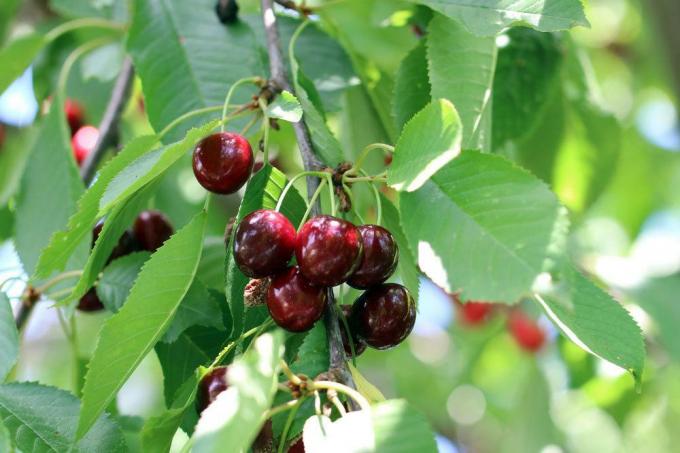
Appearance:
- Height 25 m
- pointed, elliptical leaves
- sawn leaf margins
- two nectar glands on the petiole
- yellow autumn colors
- reddish buds at the ends of the branches
- white flowers in April / May
- standing together in clusters
- round fruits initially red, later black
- edible but bitter
- light green, shiny branches
- gray to red-brown bark
- Sunny to slightly shady
- sandy-loamy soil
Mirabelle plum (Prunus domestica subsp. Syriaca)
The deciduous trees are also known as "yellow plum". They have their origin in Asia. It is a subspecies of the plum. Distantly they resemble the sloe in growth and flower shape.
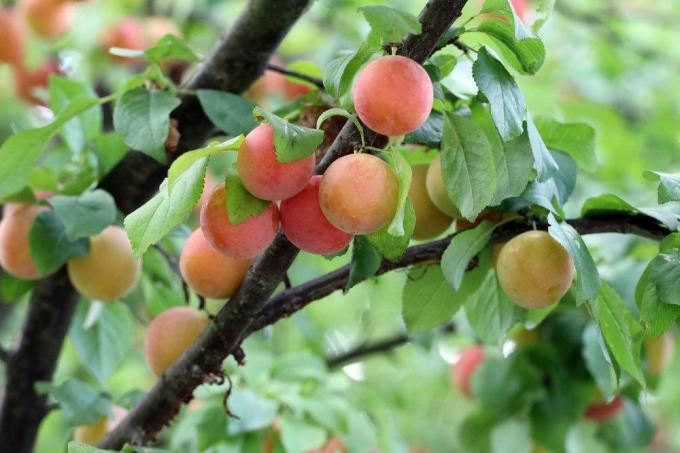
Appearance:
- Height 10 m
- ovate leaves
- smooth, dark green leaf surface
- lighter, hairy underside
- sawn leaf edge
- alternate leaf position
- yellow autumn colors
- white umbels in April / May
- sweet, yellow stone fruit
- red speckles
- Diameter 5 cm
- hairy, young branches
- light red, slightly cracked bark
- forms root runners
- sunny location
- sandy-loamy soils
Horse chestnut (Aesculus hippccastanum)
This type of chestnut has long been popular as an ornamental tree in parks and avenues. There it mainly serves as a shade provider and can live up to 200 years. The deciduous trees have a tightly arched crown with drooping branches. Your wood doesn't matter. It is only used as a veneer.

Appearance:
- Height 25 to 30 m
- fingered leaves
- usually five to seven single sheets
- double serrated leaf margin
- yellow-orange foliage in autumn
- white-yellow-red flower candles in May
- Length 20 to 30 cm, upright
- Capsule fruits (chestnuts) in autumn
- usually two chestnuts surrounded by a prickly fruit shell
- light brown to reddish brown twigs
- gray-brown, smooth bark
- later thin scaly bark, flaking
- Deep-rooted, densely branched root system
- sunny to slightly shady
- sandy-loamy soils
Sal willow (Salix caprea)
This species is preferred on rivers, ditches, moors and meadows. It is considered the most common “forest pasture” in clearings and on the edges of forests and is an important pasture for bees. The reddish wood of the Sal willow is ideal as firewood.
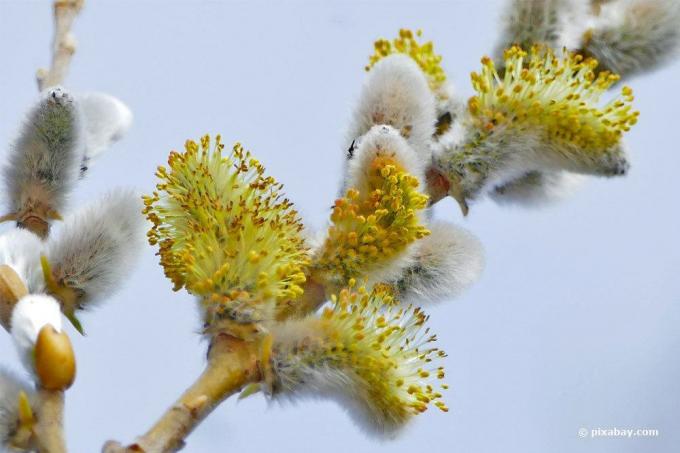
Appearance:
- Height up to 8 m
- broadly elliptical, 2 cm long stalked leaves
- perforated with entire or wavy margins
- Leaves up to 10 cm in length
- both sides felt white
- dark green, matt top
- Underside gray-green, densely downy with a yellow vein network
- Leaves shoot only after flowering in March to May
- yellow autumn colors
- egg-shaped, pointed, green-red buds
- gray-white catkins March to April
- 3 to 6 cm tall
- thin, greenish, flexible branches
- initially smooth, gray bark
- later tears open like a network
- Shallow root
- sunny to slightly shady
- sandy-loamy soils
Norway maple (Acer plantanoides)
The deciduous trees are quite adaptable and very modest in terms of their demands. Owing to their dense, egg-shaped to spherical crown, they are often planted as an avenue or park tree. The hard, glossy white wood is very popular with cabinet makers for turning.
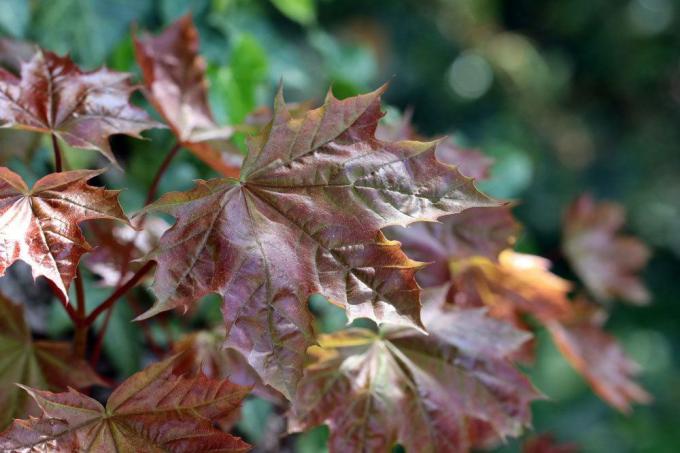
Appearance:
- Height 20 to 30 m
- mostly five-lobed, opposite leaves
- fully booked
- 8 to 12 cm long, reddish leaf stalks with leaves up to 18 cm long
- Teeth drawn out in long tips
- orange to red autumn colors
- red-brown buds
- yellow pendulous umbels in April
- fragrant
- Fruits: nuts, winged in pairs
- bare, shiny brown branches
- young shoots contain milky juice
- dark, long-cracked bark
- sunny to partially shaded
- sandy to loamy soils
Rowanberry (Sorbus aucuparia)
The undemanding deciduous tree with a loose, rounded crown is also known as mountain ash. It mainly grows in light deciduous and coniferous forests. Its fruits are edible and are used to make jams, juices and liqueurs. It also provides birds with a rich source of food in winter. Its wood is particularly suitable for carving.
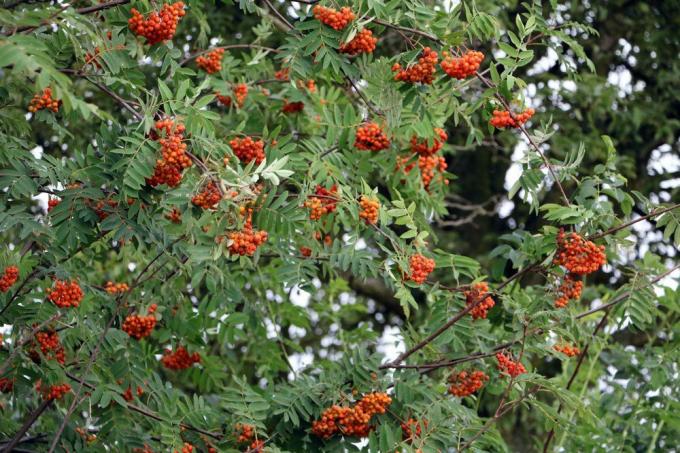
Appearance:
- Height 5 to 15 m
- up to 20 cm long, imparipinnate leaves
- 9 to 15, 2 to 6 cm elongated, elliptical leaflets
- unevenly pointed, serrated to serrated leaf margin
- Autumn orange-red color
- ovate, pointed, hairy buds
- white umbels from May to June
- pea-sized fruits in late summer
- initially green, then orange-red
- young twigs tomentose
- later bald and brown
- shiny, light gray, smooth bark
- Exfoliation in leaflets as black bark
- Shallow root
- sunny to shady
- sandy-loamy soils
Wild apple (Malus sylvestris)
This is the original form of today's apple trees. The fruits are very hard, hence the name crab apple. They are only edible when dried or cooked.
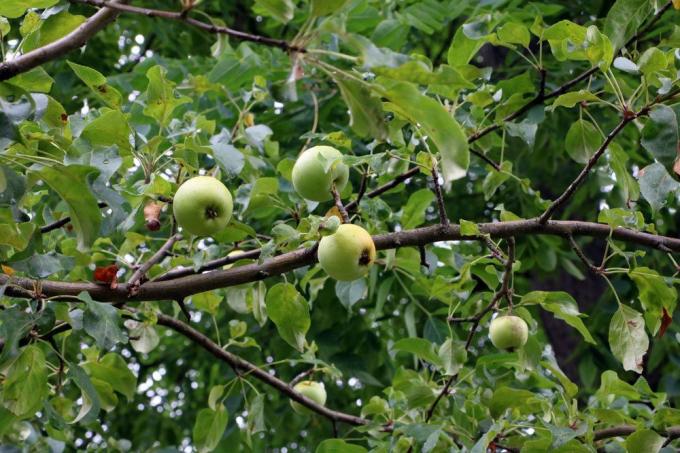
Appearance:
- Height up to 10 m
- ovate, glossy dark green leaves
- asymmetrical leaf base
- Leaf margins curved upwards and sawn
- yellow foliage in autumn
- white-pink flowers in April / May
- hard stone fruit in autumn
- red-brown branches
- gray-brown peeling bark
- lavishly branched roots
- sunny to partially shaded
- nutrient-rich soils
Quaking aspen (Populus tremula)
This deciduous tree is also known as aspen or aspen and can live up to 100 years. The leaves move with the slightest draft and begin to tremble. This is where the saying “tremble like aspen leaves” comes from. They provide food for caterpillars. The wood is very soft.

Appearance:
- Height 20 to 35 m
- egg-round, green leaves
- Bluish underside
- coarsely and irregularly bluntly serrated
- young leaves tomentose
- yellow autumn leaves
- brown, slender, egg-shaped buds
- gray-brown to greenish flowers in March / April
- olive-gray-green, brittle twigs
- initially yellow-brown bark
- later black-gray and barked
- Shallow root
- sunny to partially shaded
- fresh, loose clay and sand soils



